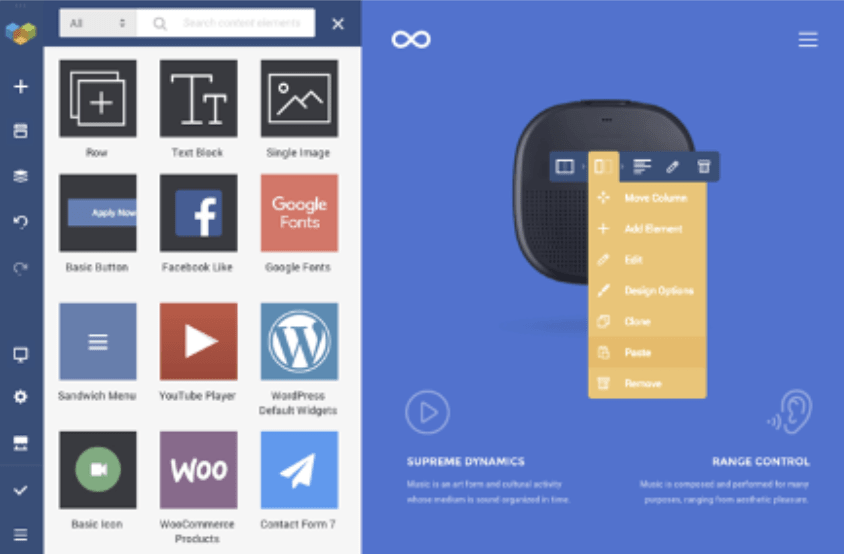Features and functionalities of WordPress and Webflow

Webflow is forming the ‘no code marketing’ revolution, with many B2B marketers considering whether Webflow can be an effective CMS for their company website. So, in this article, we scan through a number of features such as editors, integrations, customisation, back end, security, maintainability, flexibility, and more to compare the functionalities of the two CMS’s
Background
A basic web-application that supports a content-management system (CMS) is composed of two abstract blocks of functionalities, front-end and back-end. Front-end refers to the part of the website that is displayed to the end user and includes all the images, typography, buttons etc.
In contrast, back-end is the functionality that is hidden from the end-users but is the essential part of the web application as it carries out the business logic of the website. For example, if a website job is to show the current weather – the displayed weather in Celsius or Fahrenheit is front-end, and the retrieval of the weather data can be considered as back-end. It is worth mentioning that the Front-end operations are processed by the users device (e.g their web browser on their phone or computer) whereas back-end code is usually processed by the servers or the cloud.
Webflow is a Software as a Service (SaaS) based application that allows its user to build websites and publish to the web instantly. In recent years Webflow has gained attention for the level of front-end customisation it allows to the publishers who have little to no code knowledge – the ‘no code marketing revolution.’
WordPress on the other hand is an Open Source software and its evolution has turned it into a highly customisable tool from both front-end and back-end point of views. This article looks at both platforms to see how they compare and contrast on a number of features and functionalities.
Editors
The most prominent thing that WordPress shares with Webflow is front-end customisation using a Graphical editor. The default WordPress Editor is called Gutenberg which comes pre-installed with WordPress. This editor allows WordPress users to utilise pre-built components such as an image, gallery or heading. Gutenberg abstracts away most of the attributes that are used by a developer during front-end development making the editor very simple and easy to understand but limiting the customisation of the components at the same time.

On the other hand, Webflow pretty much takes all the attributes and methods of HTML and CSS and presents it in a more comprehensive graphical user interface (GUI). This allows the designers or the users to take almost full control of front-end development without any coding experience.
Since the Webflow page builder uses CSS attributes to allow this diverse functionality, this entails that the users should be aware of the meanings of these settings and should also know when one setting (attribute or property) is more suitable than another.
For instance, in order to use the provided grid system, one should know how the “position” attribute works in CSS and what does it mean for a HTML block to have “float” or “clear”. Although these attributes are a bit technical it should also be noted that a person can see the results of applying one or the other instantly that makes learning them a bit easier. Regardless of the learning curve of this mechanism for non-coders, Webflow recommends to take a courses at their University.

Both Webflow and WordPress page builder ensures that the code generated by it follows the standards for instance compliance with W3 (https://www.w3schools.com/) or WCAG, however, if a WordPress site is customised on template level it falls on developer to ensure that site complies with necessary standards.
It is worth mentioning that if someone really requires the similar level of functionality on a page builder in WordPress, this can be achieved by adding third-party plugins to the WordPress including Elementor, Visual Composer and a plugin by Webflow itself for WordPress.


Integration and back-end customisation
Webflow provides a framework for large amounts of customization on the front-end, however, compared to WordPress the back-end functionality is limited. Webflow allows installation of the plugins to their platform to extend the functionality but these plugins are based on React or their custom front-end library. WordPress on the other hand supports front-end plugins i.e. based on React.js and also back-end plugins i.e. based on PHP and WordPress core.
Ever visited a website and heard your computer running the fans? This is because the website overloads the front-end code base and executes the computationally expensive functions on the users device instead of the back-end server that they are supposed to. Back-end code abstracts away the complex tasks and runs it on the servers so the user devices do not have to exert as much computation.
Not supporting back-end also means that there will be no database or a server state. Eventually this means that one cannot create websites which involves keeping track of users i.e. membership sites, sites which interact with third-party services to obtain data and process it i.e. real estate sites.
So in some respects for certain sites Webflow might be more limited in how far it can be taken, but it still is a great choice for a more simple design led site.
Open Source (WordPress) vs. Proprietary Software (Webflow)
Being the open source software, WordPress inherits all the pros and cons of an Open Source system:
- free availability
- developed by a large community of developers
- regular updates of the software to the current industry standards
- sustainable security
- users do not get locked-in with one vendor (i.e., If one agency has built a WordPress site they are not the only ones who can maintain it)
- freedom to develop and extend the site in any direction
The disadvantages are that it requires some maintainability i.e. if an update comes, one has to install those updates and it can also suffer from zero-day threats.
In contrast, a proprietary software is managed by an organisation such as Webflow, updates are dependent on that organisation entirely. In this case the support is good but limited.
Consider a scenario where a website is built by a proprietary vendor and the website stops responding, the support team will no doubt be quick at restoring the website. Now consider that one requires the vendor to make some changes to the website that has some level of complexity and the framework does not support that feature yet, then it will be a very long process and it is likely that change might not get done.
Security
Generally the biggest challenge in software security is that one has to know and secure an order of magnitude of vulnerabilities whereas an adversary has to exploit just one significant vulnerability to break-through. This is both a challenge and an advantage to an open source software. It is a challenge because the source code is freely distributed and many people are aware of the weaknesses in the source code.
On the other hand this is also an advantage because as soon as the security community (i.e. WordFence) comes across a vulnerability they immediately patch it making the software more robust in the long-run. In contrast to that, a software which is closed source or that would not suffer from insecurities because no one knows the underlying source code of the software, thus, no one knows the weakness of it – this phenomenon is known as Security Through Obscurity.
In a system like WordPress one requires support by developers who can manage and keep the system updated, where Webflow updates and remains secure automatically. If one has to manage their website themselves, choosing Webflow over WordPress is advantageous as the user will always get some level of security even without doing anything because the software vendor is responsible for the security. WordPress on the other hand will need to be updated in order to stay on top of security, and can be best managed by an agency or in-house team of developers to support the site.
SEO
WordPress is well known for having strong SEO foundations. It is naturally a very SEO optimised platform, and it provides a perfect platform for scalable SEO driven content publishing. On top of this, it is very extendable in terms of SEO. There are powerful plugins that give marketers and SEO lots of ability to further optimise their sites, like Yoast and RankMath. And then there are even more advanced plugins like WP SEO Structured Data Schema that allows you to add structured markup to your pages. And even beyond that, plugins like WordLift bring another level of powerful AI to SEO for WordPress.
Comparatively Webflow has standard settings to manage SEO for pages on the site. You can add SEO titles and meta descriptions, but that’s more or less it, you don’t have much control over SEO settings beyond this. And because Webflow is a SaaS platform, no new SEO features will be added unless Webflow develop them, whereas anyone is able to produce a WordPress plugin.
So Webflow is not necessarily less SEO friendly than WordPress as a platform, but there it is certainly more restricted in terms of what you can do when it comes to SEO compared to some of the options above for WordPress. If SEO is an important channel for you, you would need to plan carefully, scope your SEO requirements and make sure you don’t go backwards in terms of SEO results if you moved a site over to Webflow.
Maintainability, scalability, and publishing to the web
Webflow is built on top of Amazon Web Services (AWS) and it comes with features like Back-up, password-protection for individual pages, Content distribution network and maintained security services. The websites published with Webflow are highly scalable and well supported.
Conversely, A custom WordPress build requires to be hosted manually by a developer. This means that WordPress can be hosted on any cloud such as Microsoft Azure, AWS or GoDaddy. However, there are WordPress maintained hosting such as WP Engine which provides a similar managed service as Webflow provides to their end-users.
Webflow based websites can be easily published to the web with a few clicks whereas WordPress would require some level of development or hosting experience to do that unless the hosting is WordPress maintained hosting.
Conclusion
When it comes to front-end development, Webflow seems to be a very comprehensive tool but it does have a sharp learning curve to it. Webflow is a perfect tool for someone who knows how to design the websites and does not have requirements for complex business logics I.e. using third-party services, API integrations or running computationally expensive processes.
In contrast, WordPress is a good tool for someone who has more complex business requirements, for more dynamic and content rich sites, and requires the website to have more bespoke functionality that can be managed by marketing in a way that scales, without needing design assistance.
We think both WordPress and Weblow are great tools. There is no such this as the ‘perfect CMS’, but both Weblow and WordPress can be fantastic platform for different types of sites.

How to ‘deliver’ – the key tenets to establishing partnerships with your clients

Raise your voice: how to optimise your website for voice search
Let's Talk
Do you have a web design and build project coming up that you would like to talk about?